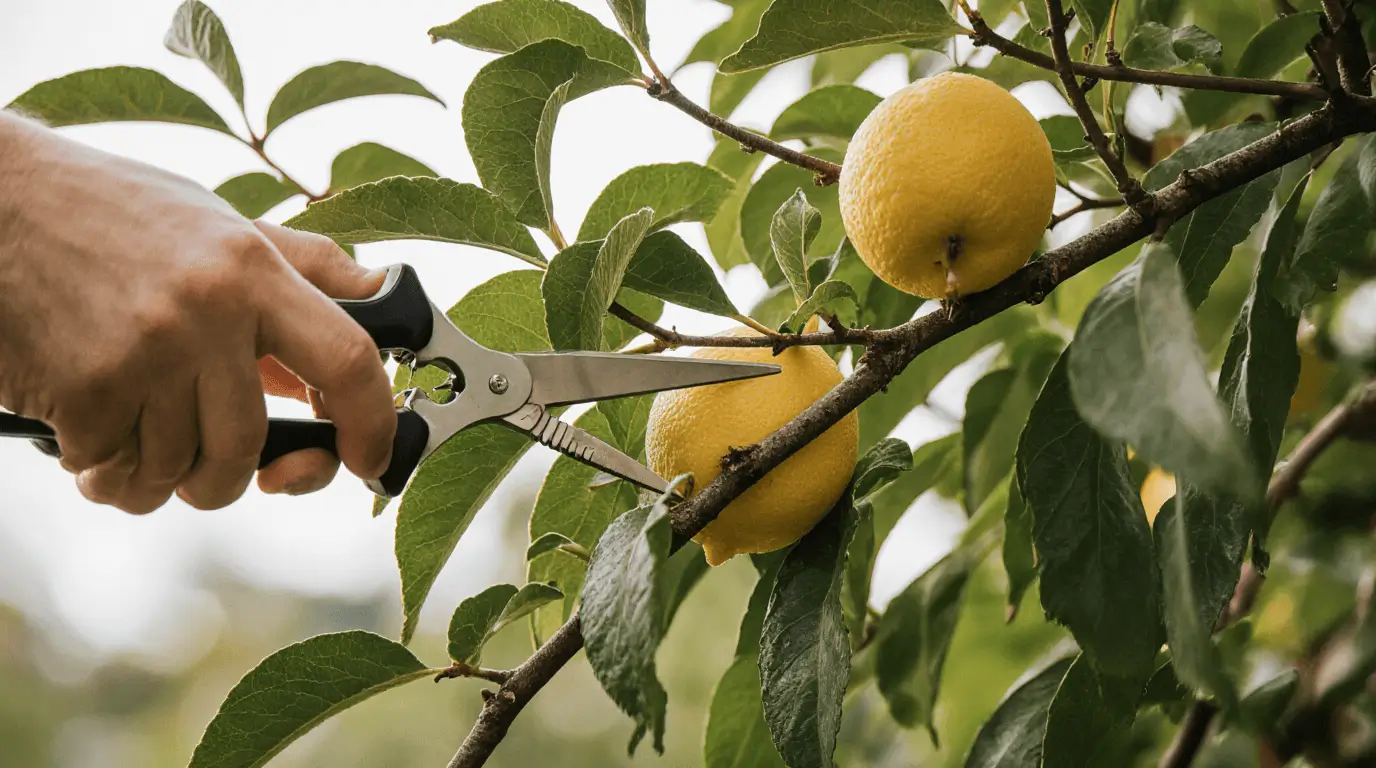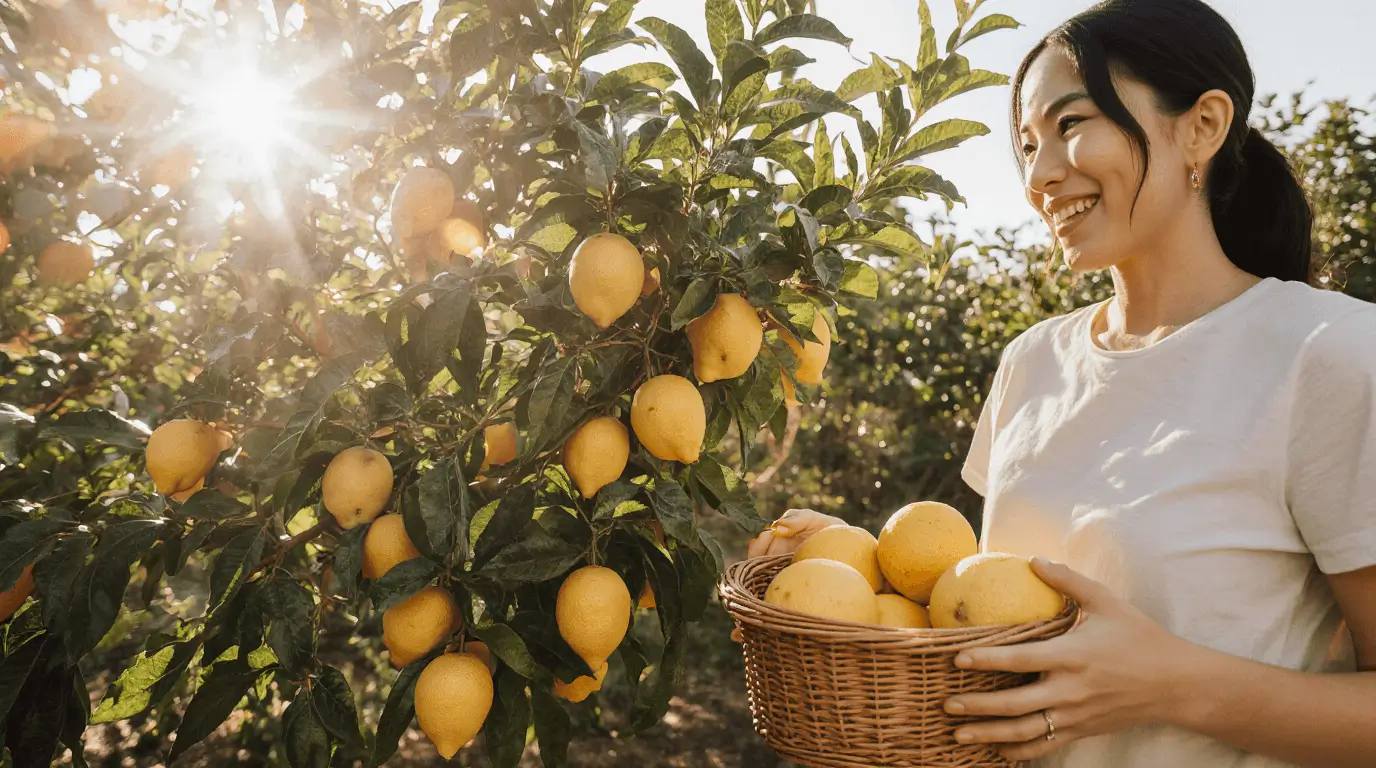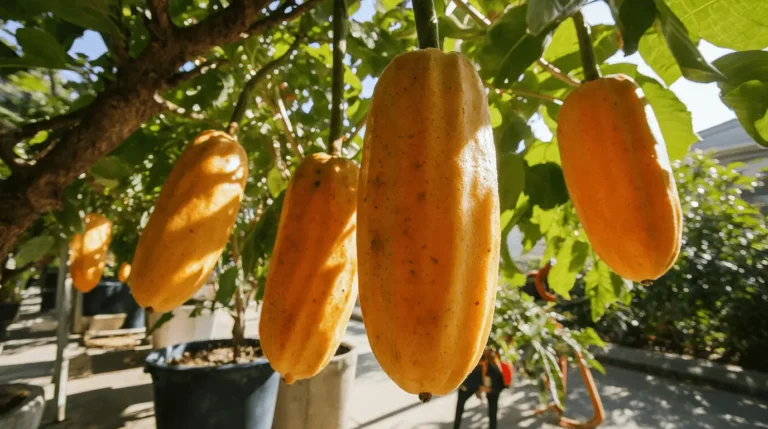When I first brought home my Meyer lemon tree, I was amazed by its lovely flowers and refreshing flowery smell that filled the garden. This citrus beauty, known by its botanical name Citrus x meyeri, is a hybrid between a lemon and an orange, which explains its pleasantly sweet yet slightly sour fruit. Unlike regular lemons, the yellow fruit has a smooth skin, thin skin, and a juicy pulp with a soft orange-yellow tone. As a home gardener, I enjoy using its tangy flavor in jams, seafood, baked goods, dressings, and refreshing drinks. The tree grows up to 10 feet tall with dark green leaves and beautiful white blooms that appear in spring and sometimes again in fall. Its flower color often shows a faint purple base, adding to its charm and making it a favorite among Dwarf Lemon Tree fans. Meyer lemon plant care is essential to keep this beautiful tree thriving year after year.
To make your evergreen plant type thrive, focus on its environment and daily care. Provide plenty of sunshine—at least 6-8 hours of direct sunlight and full sun exposure—to ensure healthy growing. Use well-draining, loamy soil that’s slightly acidic, keeping the soil pH around pH 6.0-7.0. Avoid waterlogged conditions by ensuring good drainage and sticking to regular watering that keeps the moist soil balanced but not soggy. During winter, move container-grown trees or pots indoors or to cooler climates to prevent cold damage and maintain frost protection. These trees reach a mature size of about 6-10 feet, perfect for USDA Zones 9-11, and adapt well when grown indoors in small spaces. With steady attention and the right balance of light, warmth, and moisture, the Meyer lemon tree rewards you with a lasting display of beauty and flavor.
| Category | Details |
| Botanical Name | Citrus x meyeri |
| Common Names | Meyer Lemon Tree, Dwarf Lemon Tree |
| Plant Type | Evergreen fruit tree |
| Mature Size | 6-10 feet tall |
| Sun Exposure | Full sun, 6-8 hours of direct sunlight |
| Soil Type | Well-draining, loamy soil, slightly acidic |
| Soil pH | pH 6.0-7.0 |
| Watering Needs | Regular watering, keep moist soil, avoid waterlogged |
| Bloom Time | Spring, sometimes in fall |
| Flower Color | White with a purple base |
| Hardiness Zones | USDA Zones 9-11 |
| Special Care | Frost protection, move indoors during cold or winter |
Tips to Grow and Care for Citrus Meyer Lemon Trees
When I first started growing Meyer lemon trees in my garden, I quickly learned that these citrus beauties need special care to truly thrive. Their fragrant flowers and gentle fragrance fill the air with freshness, while the sweet fruit and bright blossoms make any tropical space look wonderful. For home gardeners, it’s important to know the right tips—provide plenty of sunlight, consistent watering, and a well-balanced fertilizer to keep the tree healthy and strong. Proper pruning helps new leaves grow and keeps the shape tidy. Whether grown indoors or outdoors, choose a large container or pot with rich soil and stable temperature to encourage the best growth. With regular nurturing and patience, you’ll enjoy a rewarding harvest, making your garden a perfect addition to nature’s beauty.
Choosing the Right Spot

From my experience with Meyer lemon trees, finding the perfect place makes all the difference. These citrus trees love plenty of sunshine, needing about 6-8 hours each day to stay healthy. Less sun often means fewer blossoms and less fruit, so I always make sure mine are planted outside in a sunny spot that’s sheltered from wind—this protects the tree and helps the fruit set properly.
Good soil that drains well is a must, and I test my dirt to be slightly acidic, keeping the pH 6.0-7.0 range just right. I sometimes amend the soil to create an ideal growing environment. Also, give them enough space since they can reach about 10 feet tall and wide at maturity; providing room helps prevent overcrowding and keeps your garden balanced and thriving.
“If you’re planning your garden layout, learn how big lemon trees can grow to space them perfectly.”
Planting Your Tree

From my own gardening experience, the best time to plant Meyer lemon trees or citrus Meyer trees is during late winter or early spring when the weather is mild. Always avoid freezing temperatures or extreme heat to improve survival rates.
I usually dig a hole twice as wide but not deeper than the root ball, then carefully place it in and backfill with native soil mixed with rich organic matter. After that, I water thoroughly until the soil settles. Adding staking gives the tree extra support in windy areas, especially for young plants. Make sure the soil stays loose, aerated, and maintains a pH 6-7 balance for ideal growth.
For best results, always use a nutrient-rich mix and ensure roots have breathing space.
Proper Water Needs

From my experience caring for Meyer lemon trees, I’ve learned that consistent and deep watering is absolutely crucial for their health. Always soak the entire root zone, then allow the soil to dry out slightly before watering again.
During warm months, I water about every 7-10 days, adjusting based on heat, size, and soil type, and less often in cool weather. If you notice drooping leaves or dropping fruit, it’s a sign of under-watering, while overwatering can cause serious damages to roots, leading to yellow or curled foliage.
I like adding about 2-3 inches of organic mulch around the base to lock in moisture and discourage weeds, but make sure it never touches the trunk to avoid possible rot. This small step helps maintain steady moisture levels and supports strong, healthy growth year-round.
Feed for Best Growth
To help Meyer lemon trees achieve robust expansion and produce plentiful flowers, I always use a citrus-specific formula fertilizer with higher nitrogen content. It’s best to apply it according to the package directions, starting in early spring and continuing every 4-6 weeks through summer for steady nourishment. Equally important are micronutrients, as yellowing leaves often signal iron deficiency. I recommend using a micronutrient spray or soil amendments when necessary to nurture a vibrant, flourishing tree that thrives beautifully in your garden.
“Along with feeding, proper pest and disease management ensures your Meyer lemon tree stays healthy year-round.”
“The Royal Horticultural Society also recommends citrus-specific fertilizer schedules for consistent flowering and fruiting.”
Proper Pruning

From my experience, annual pruning keeps Meyer lemon trees in good shape and looking healthy. I usually trim them in late winter before spring growth begins, making sure to remove dead branches and damaged branches. It’s also smart to cut off congested branches to create the best structure for strong, balanced growth.
Flowering and Fruiting Meyer Lemon Trees
The sweet scent of Meyer lemon blossoms is one of my favorite signs of spring. In late winter and early spring, delicate flower buds begin to open, and within a week or so, new blooms start unfurling for several weeks. For outdoor trees, bees handle pollination, but for container lemon trees, I gently use a small soft brush inside each flower to transfer pollen when bees are scarce. This simple step encourages adequate fruit sets and ensures your tree stays productive through the season.
As the tiny green fruits appear, proper thinning helps maintain the best growth and flavor. I usually remove the smallest fruits, leaving each remaining lemon enough space to reach a large size—around 4-6 inches apart for optimal results. This allows the tree to focus its energy where it matters most, resulting in strong, flavorful fruit that embodies the beauty of home gardening.
Harvesting Juicy Meyer Lemons
From my own garden experience, Meyer lemon trees usually take about 6-9 months after flowering to ripen fully. When I see plump lemons turning from dark to light yellow and feeling slightly soft with thin skin, that’s my signal to twist the fruit gently and pull to pick without damaging the tree. I like to use or preserve them right away and store a few at room temperature for about a week, since their thin skins don’t support long-term storage. These lemons are perfect for delightful additions in recipes, bringing out their sweeter juice and fresh, sunny flavor.
Caring for Trees in Winter
During winter, I always give my Meyer lemon trees some extra care and protection to help them thrive through the cold. Potted dwarf trees are carefully moved inside before temperatures drop, placing them in the sunniest indoor spot I can find. For in-ground trees in cold climates, I wrap and drape the branches using burlap, old blankets, sheets, straw, or even bubble wrap to insulate the citrus from harsh winds and freezing nights. I also water less since the plants become dormant and need time to rest until the warmth returns.
Troubleshooting Issues
Staying vigilant helps your plant avoid problems, even if your well-cared-for Meyer lemon trees occasionally struggle. Watch out for spider mites and aphids that may infest leaves, leaving behind stippling or curling leaves. To handle these pests, rinse with water first, then apply insecticides if needed. Yellowed foliage or stunted growth often means nutrients lacking, so test soil and amend accordingly. With attentive care and protection, your trees will flourish for many years, offering sweet citrus goodness to savor each season.
“For more quick-fruiting options, check out these fast producing fruit trees and vines that thrive in warm climates.”
Conclusion
Caring for Meyer lemon trees may require patience, but the rewards are truly worth it. From proper watering and pruning to feeding, pollination, and winter protection, each step plays a role in helping your plant flourish. Staying vigilant against pests, maintaining good soil, and providing enough sunshine ensures steady growth and rich fruiting every season. With attentive care, these trees will continue producing sweet citrus goodness for years to come—turning your garden into a vibrant, fragrant haven.
Read Also: Gardening & Plant Care Guide for Thriving Plants

FAQs
- How often should I water my Meyer lemon tree?
Water deeply once every 7–10 days, allowing the soil to dry slightly between waterings. During cooler months, water less to avoid overwatering and root damage. - Why are my Meyer lemon tree leaves turning yellow?
Yellowed foliage often signals nutrient deficiencies, such as a lack of iron or nitrogen. Try adding micronutrients or a citrus-specific fertilizer to amend the soil. - When should I prune my Meyer lemon tree?
Perform annual pruning in late winter before spring growth starts. Remove dead or damaged branches and trim congested areas for better air flow and shape. - How can I protect my tree in winter?
Move potted dwarf trees inside before temperatures drop, and wrap or insulate in-ground trees with burlap, blankets, or straw to prevent freezing damage. - When is the best time to harvest Meyer lemons?
They typically take about 6–9 months to ripen after flowering. Pick them when the fruit turns light yellow, feels slightly soft, and has thin skin for the juiciest flavor.




